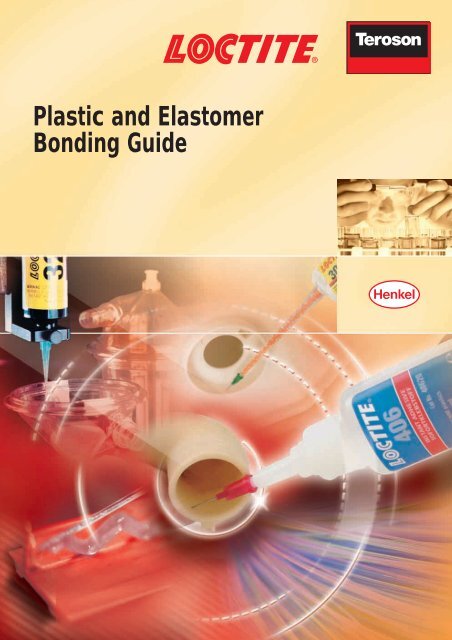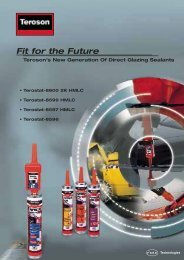Plastic and Elastomer Bonding Guide - Henkel
Plastic and Elastomer Bonding Guide - Henkel
Plastic and Elastomer Bonding Guide - Henkel
Create successful ePaper yourself
Turn your PDF publications into a flip-book with our unique Google optimized e-Paper software.
<strong>Plastic</strong> <strong>and</strong> <strong>Elastomer</strong><strong>Bonding</strong> <strong>Guide</strong>3
ThermoplasticsABS* ASA* LCP PA6 PBT PC* PE PEEK PEI PES* PET PI PMMA* POM PP PPO* PS* PTFE PVC-P PVC-U* SAN*1 minimum one substrate must be transparent or UV transparent2 corrosion protected metals only3 for reinforced plastics: CRP (carbon-fibre reinforced plastics): heavy abrading may decrease bondabilityGRP (glass-fibre reinforced plastics): abrading always increases bondability4 It is recommended to clean the surfaces before bonding or pretreatment. Refer to the nature of the substrate <strong>and</strong> use the appropriate cleanerOperating Temperature Strength Gap filling°C N/mm 2 mm-60 -40 Room 80 100 120 150 200 300 0 1 3 5 10 20 30temperatureBond strength depends on substrate <strong>and</strong> load type.Regarding bondability of substrate see selection table.0.0 0.1 0.25 0.5 1 3
Thermoset<strong>Elastomer</strong>sTPU* EP MF PF UP CR EPDM IR NBR NR PU SBR SI TPEGlassMetalLoctite ® <strong>and</strong> Terosonproduct examples401, 406, 480CA + Primer 770430495143430, 9461, 9483,9489, 94923298 + Activator 73863292, 329530303311, 3321, 33412Teromix 6700Terokal 2444Terostat 92205910, 597050882Terostat-PU 9270637070e.g. Rougheninge.g. Plasma, CoronaAbove chart contains general information. Please contact your local <strong>Henkel</strong> Representative for your special Loctite ® or Teroson solution.Flexibilitystaticdynamic EnvironmentalresistanceThe environmental resistance of bonded joints dependson many different factors including the gap betweenthe parts, the surface finish, the joint design, the typeof adhesive selected, the load on the joint <strong>and</strong> theoperating environment. Please refer to the TechnicalData Sheets or contact your local <strong>Henkel</strong> TechnicalCentre for more details <strong>and</strong> advice.%500 100 10 3 1 0 0.5 1 20 25® designates a trademark of <strong>Henkel</strong> KGaA or its affiliates, registered in Germany <strong>and</strong> elsewhere © <strong>Henkel</strong> KGaA, 2005
<strong>Henkel</strong> –The Solution ProviderThe <strong>Henkel</strong> portfolio includes the following groups of Loctite ® <strong>and</strong> Teroson adhesivesfor bonding plastics <strong>and</strong> elastomers:• Cyanoacrylates, more commonly known as instant adhesives, are very fast curing, single componentadhesives• Epoxy adhesives (one-part <strong>and</strong> two-part systems) cure into tough <strong>and</strong> very strong thermosets withgood resistance against a wide range of chemicals• Acrylic adhesives have good gap filling properties <strong>and</strong> good peel <strong>and</strong> impact resistance• 2-component PUR adhesives cure to form strong, tough thermoset materials• Contact adhesives reach h<strong>and</strong>ling strength right after assembly• MS-Polymers achieve good adhesion to various substrates <strong>and</strong> have good UV resistance <strong>and</strong>high flexibility• Silicone adhesives cure to form elastomers which are highly flexible, show very good weathering<strong>and</strong> outst<strong>and</strong>ing temperature resistance• Flexible polyurethane adhesives are cured by ambient moisture to form highly flexible, paintableelastomers with good chemical resistanceSurface preparationCorrect surface preparation is critical to achieving optimum bond strength <strong>and</strong> joint reliability. <strong>Henkel</strong>offers suitable cleaners like Loctite ® 7063 <strong>and</strong> 7070 to make sure that surfaces to be bonded are clean<strong>and</strong> free from grease, oil <strong>and</strong> other impurities that may affect adhesion <strong>and</strong> bond strength.Other pre-treatments to further enhance adhesive bond performance include:• Mechanical treatment such as grinding <strong>and</strong> blasting to generate a rough surface texture• Physical treatments such as corona discharge, flame or plasma techniques to improve the bondabilityof plastics <strong>and</strong> elastomers• Primers, recommended as adhesion promoters for certain plastic <strong>and</strong> elastomer formulations<strong>Henkel</strong> Loctite Adhesives LtdTechnologies HouseWood Lane EndHemel HempsteadHertfordshire HP2 4RQTel. 01442 278100Fax 01442 278293www.loctite.co.ukThe data contained herein are intended as reference only. Please contact your local <strong>Henkel</strong> Technical Support Group for assistance <strong>and</strong> recommendationon specifications for these products.® designates a trademark of <strong>Henkel</strong> KGaA or its affiliates, registered in Germany <strong>and</strong> elsewhere © <strong>Henkel</strong> KGaA, 2005
















